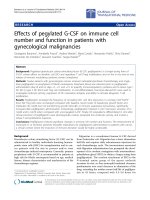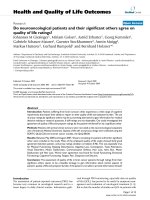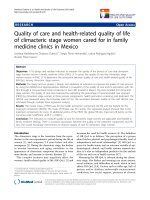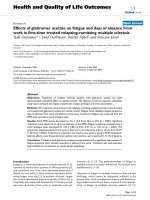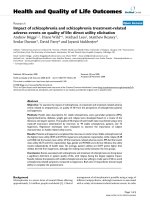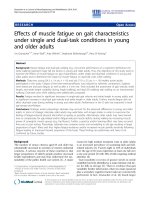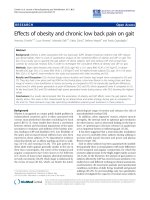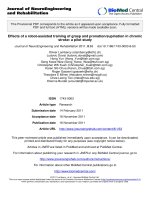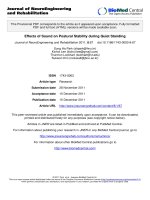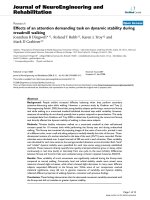Báo cáo hóa học: " Effects of obesity and chronic low back pain on gait" docx
Bạn đang xem bản rút gọn của tài liệu. Xem và tải ngay bản đầy đủ của tài liệu tại đây (225.15 KB, 7 trang )
RESEARCH Open Access
Effects of obesity and chronic low back pain on gait
Veronica Cimolin
1,2*
, Luca Vismara
2
, Manuela Galli
1,3
, Fabio Zaina
4
, Stefano Negrini
4
and Paolo Capodaglio
2
Abstract
Background: Obesity is often associated with low back pain (LBP). Despite empirical evidence that LBP induces
gait abnormalities, there is a lack of quantitative analysis of the combined effect of obesity and LBP on gait. The
aim of our study was to quantify the gait pattern of obese subjects with and without LBP and normal-mass
controls by using Gait Analysis (GA), in order to investigate the cumulative effects of obesity and LBP on gait.
Methods: Eight obese females with chronic LBP (OLG; age: 40.5 ± 10.1 years; BMI: 42.39 ± 5.47 Kg/m
2
), 10 obese
females (OG; age: 33.6 ± 5.2 years; BMI: 39.26 ± 2.39 Kg/m
2
) and 10 healthy female subjects (CG; age: 33.4 ± 9.6 years;
BMI: 22.8 ± 3.2 Kg/m
2
), were enrolled in this study and assessed with video recording and GA.
Results and Discussion: OLG showed longer stance duration and shorter step length when compared to OG and
CG. They also had a lo w pelvis and hip ROM on the frontal plane, a low knee flexion in the swing phase and knee
range of motion, a low dorsiflexion in stance and swing as compared to OG. No statistically significant differences
were found in ankle power generation at push-off between OLG and OG, which appeared lower if compared to CG.
At hip level, both OLG and OG exhibited high power generation levels during stance, with OLG showing the highest
values.
Conclusions: Our results demonstrated that the association of obesity and LBP affects more the gait pattern than
obesity alone. OLG were in fact characterised by an altered knee and ankle strategy during gait as compared to
OG and CG. These elements may help optimizing rehabilitation planning and treatment in these patients.
Background
Obesity is recognised as a major public health problem in
industrialized countries and it is often associated with
various musculoskeletal disorders including low back
pain (LBP) [1-3]. Some studies have shown a correlation
between obesity and functional impairment of the spine
secondary to weakness and stiffness of the lumbar mus-
cles, leading to LBP and disability [4-6]. Low flexibility of
the spine and increased dorsal stiffness have also been
reported in obese subjects [7-9]. Quantitative evidence
exists that obesity per se affects standing up [10,11], walk-
ing [12-14] and running [15,16]. The gait pattern in
obese adult males appears generally similar to the one in
their lean counterparts, but some of the temporal and
angular components have been shown to be different
[17]. Excess of mass in fact imposes abnormal mechanics
on body movements [18,19 ]. Body shape is influenced by
the excess of mass [20-22], which can hinder the joints’
physiological range of motion and enhance the risk of
musculoskeletal overload [18].
In addition, other segments’ masses, relative muscle
strengths, the internal need to optimize gait mechanics
for other factors , such as decreased loading on the hip or
knee, or optimizing to decrease reliance o n quadriceps
act as important factors in influencing gait [17,23].
It has been suggested that a neuromuscular modulation
may occur in morbidly obese subjects during walking to
increase ankle muscle function and power and plantar
flexion torque [16].
Gait in obese subjects has been quantitatively studied:
they generally show a normal pattern with some dif ferences
in the temporal and angular components, for which t he
excessive adipose tissue in th e thighs might mainly account
[15,17,24]. In the literature, the analysis of gait pattern in
subjects affected by LBP has received scant attention. Few
studies have used different techniques (clinical assessment,
accelerometers, 3D movement analysis) and experimental
conditions (activities of daily living, treadmill and grou nd
walking) [25-29]. To our knowledge only two quantitative
studies investigated the capacity of normal-mass subjects
* Correspondence:
1
Bioengineering Department, Politecnico di Milano, Italy
Full list of author information is available at the end of the article
Cimolin et al. Journal of NeuroEngineering and Rehabilitation 2011, 8:55
/>JNER
JOURNAL OF NEUROENGINEERING
AND REHABILITATION
© 2011 Cimolin et al; licensee BioMed Central Ltd. This is an Open Access article distributed under the terms of the Creative Commons
Attribution License ( g/licenses/by/2.0), which permits unrestricted use, distribution, and reproduction in
any med ium, provided the original work is properly cited.
with LBP vs. those without to adapt their gait pattern to
different velocities during treadmill walking [27,28]. These
analyses were conducted in terms of trunk and pelvis rota-
tions and erector spinae muscular activity in order to evalu-
ate the trunk-pelvis coordination. They found that LBP
patients had difficulties in modulating trunk-pelvis coordi-
nation, especially on the transversal plane, and erector
spinae activity following velocity perturbations. In another
study, Spenkelink et al. [26] investigated differences
between LBP patients and healthy subjects in daily living
activities and the day-to-day variability using an ambulant
monitoring system based on accelerometers. In this study,
LBP patients showed lower activity levels with lower gait
velocity and time spent in standing positio n and greater
time spent resting than the control group.
Despite being frequently associated, the effects of LBP
and obesity on biomechanical gait parameters have been
investigated separately. None of them has investigated the
combined effects of obesity and LBP and the quantitative
differences in gait strategy in obese with LBP as compared
to those without LBP. We have previously shown [9] that
in those subjects LBP maybe a consequence of obesity
itself and it could possibly be prevented by weight loss and
specific spine exercises. Our hypothesis was that LBP com-
bined with obesity might worsen the gait pattern of obese
subjects. Bearing in mind that walking is a key component
of comprehensive rehabilitation in obesity, verifying our
hypothesis would reinforce the need for specific and pre-
ventive spine exercises and weight loss programmes.
A deeper understanding o f the causes of their gait
abnormalities, and ultimately of their motor disability, may
help optimizing rehabilitation planning and treatment. 3-D
Gait Analysis (GA) is nowadays the most accurate tool to
investigate the gait pattern. From a clinical perspective,
measuring the joint angular displacement, reactions,
moments and powers provides insight into the ‘how’ (kine-
matics) and the ‘why’ (kinetics) of the movement observed.
No studies up to now have addressed this issue of defining
quantitative differences in gait strategy in patients with
obesity and LBP.
The aim of our study was therefore to quantify the gait
pattern o f obese subjects with and without LBP and
normal-mass controls by using GA, in order to investigate
the combined effects of obesity and LBP on gait.
Materials and methods
Participants
We included in the study 8 obese females (BMI ≥ 35 Kg/
m
2
) with chronic LBP (OLG group). According to the Ita-
lian Guidelines on LBP [30], chronic LBP was defined as
lumbar pain with no evidence of specific origin lasting
more than 3 months. Our subjects had a chronic non-spe-
cific pain and were not under any medication at the time of
the experiment. We excluded subjects with secondary LBP,
sciatica, osteoporosis, osteoarthritis, rheumatologic, meta-
bolic or hematologic abnormality with potential to affect
lower limb function and neurological diseases precludin g
physical exercise, cardio-respiratory conditions (diagnosed
after treadmill stress tests), acute illnesses. Two control
groups were recruited for this study: the first group
included 10 matched obese females without LBP (OG) and
the second one included 10 age-matched normal-mass
females (CG). OG and CG reported no history of LBP dur-
ing the last six months.
All the obese participants were admitted to our Unit
for multidisciplinary rehabilitation program for obesity.
We considered three groups of female subjects in order
to avoid gender differences and because the prevalence of
LBP is greater in women than in men [31].
All the subjects were able to understand and complete
the test and walk independently without aids. They did
not report pain while walking.
The study was approved by the Ethics Research Com-
mittee of our Institute and written informed consent was
obtained from the patients.
Methods
Physical evaluation included: height (expressed in
meters), waist circumference, and mass (expressed in Kg)
determination. Moreover, BMI (kg/m
2
) was calculated.
Waist circumference was measured with a plastic tape
midway between the lowest rib and iliac crest with the
subject standing at the end of gentle expiration and
expressed in cm [32]. All the details of t he three groups
are reported in Table 2.
The clinical examination included palpation of the
paravertebral muscles , straigh t leg raising test for sciatic
nerve impingement, tendon reflexes of the lower limbs.
Subjective perception of pain was evaluated with a
Visual Analogue Scale (0-10).
All subjects were randomly evaluated at the Move-
ment Analysis Lab of our Institu te using an optoelectro-
nic system with 6 cameras (460 VICON, Oxford Metrics
Ltd., Oxford, UK) with a sampling rate of 100 Hz, and
two force platforms (Kistler, CH).
The optoelectronic system performs a real time pro-
cessing of images from 6 fixed infra-red cameras to
extract the reflectance of passive markers (with a dia-
meter of 15 mm) which are positioned on specific ana-
tomical landmarks of the subject. Prior to testing, the
system was calibra ted to assure accuracy and to allow
the computation of each marker’s 3D coordinates using
a right-han ded coordinate system and standing calibra-
tions were performed on all subjects prior to data col-
lection. The accuracy (Mean Residual) was 0.87 mm and
the static reproducibility was 0.81%.
To evaluate the kinematics of each body segment, pas-
sive markers were positioned on the subject’sbody,as
Cimolin et al. Journal of NeuroEngineering and Rehabilitation 2011, 8:55
/>Page 2 of 7
described by Davis [33]. Particular attention was taken
for placement of the markers, especially at the pelvis
(anterior superior iliac spine and posterior superior iliac
spine). After placement of the markers, subjects were
asked to walk barefoot at their o wn natural pace (self-
selected speed) along a walkway with embedded force
platforms at the mid-point. At least six acquisitions
were collected for each patien t in order to guar antee
reproducibility of the results.
Data analysis
The 3D orientation of body segments of interest (pelvis,
left and right thighs, left and right shanks, both feet) was
obtained by tracking trajectories according to a common
commercially available kinematic model (Plug-In-Gait,
Vicon Peak, Oxford, UK). All graphs obtained from GA
were normalized as % of g ait cycle and kinetic data were
normalized for individual body mass.
From the analysis of these graphs we identified some
param eters (time/distance parameters, joint angle values
at specific instances of the gait cycle, peak values in
joint power graphs). Among all parameters calculated,
we selected the most reliable and consistent for analyses
in individuals characterised by obesity [14,17,24,34]
(Table 1):
Spatio-temporal parameters:
- % stance (as % of the gait cycle);
- Double stance phase (as % of the gait cycle);
- mean velocity, normalised for individual height (1/s);
- step length, normalised for individual height;
- cadence: number of steps in a time unit (steps/min).
Kinematics:
- the values of angle of ankle (AIC index) and knee
(KIC index) at the Initial Contact (IC);
- the values of an kle dorsiflexion peak during stance
(AMSt index) and swing phase (AMSw index) and the
peak of knee flexion (KMSw index) during swing;
- the values of peak of ankle plantarflexion in stance
(AmSt index) and of knee extension (KmSt index) during
the gait cycle;
- the hip ROM on the coronal (HAA-ROM index) and
sagittal (HFE-ROM) plane; the knee ROM (KFE-ROM
index) on the sagittal plane; the ankle ROM on the
sagittal plane during stance (ADP-ROM index).
Kinetics:
- the maximum value of absorbed power during load-
ing response and mid-stance (respectively from 0% to
10% and from 10% to 30% of the gait cycle); APmin
index, W/Kg), representing the ability to absorb the
impact of the foot to the ground;
- the maximum ankle power during terminal stance
(from 30% to 50% of th e gait cycle) (APMax i ndex, W/Kg),
representing the push-of f capacity duri ng walking and
related to the forward propulsive power during gait;
- the maximum value of the generated hip power in
midstance (from 10% to 30% of the gai t cycle) (maxi-
mum value of positive hip power in the first phase of
stance; HPMax index, W/Kg).
Statistical analysis
All the previously defined parameters were computed
bilaterally f or each participant and the mean and stan-
dard deviation values of a ll indexes were calculated for
each group. Data of the right and the left side were
compared using Wilcoxon signed rank test.
Kolomogorov-Smirnov tests were used to verify if the
parameters were normally distributed; the parameters
were not normally distributed, so we used analysis of var-
iance for nonparametric (Kruskall-Wallis) data followed
by a post hoc range analysis. The post hoc ran ge analysis
was performed using the Man n-Whitney U-test. P-values
less than 0.05 were considered significant.
Further the differences between OLG and OG were
estimated using the Cohen effect size (d’)[35].Respon-
siveness is considered to be “trivial” for d’ <0.20,“small”
for 0.20 ≤ d’ <0.50,“ moderate” for 0.50 ≤ d’ <0.80,and
“large” for d’ ≥ 0.80.
Results
Age did not significantly differ among groups. BMI, mass
and height were similar in OLG and OG but significantly
different from CG (Table 2). OLG and OG showed larger
waist circumference than CG, with OLG significantly lar-
ger than OG. The BMI between the OLG and OG groups
was similar but the waist measurement was significantly
greater in the OLG versus the OG group. The VAS score
was 5.9 ± 1.8 for OLG and it was 0 for OG and CG.
First, a comparison between all the parameters (spa-
tio-temporal, kinematic and kinetic) of the right and left
limb was made for all participants. No significant differ-
ences were found between the two limbs, indicating a
symmetric gait pattern. Subsequently, data from both
sides were pooled.
In Table 3 I, the mean value s and standard deviations
of the spatio-temporal, kinematic and kinetic indexes for
the three groups are reported.
As for the spatio-temporal parameters, OLG were
characterised by significantly longer stance duration and
by shorter step length than OG and CG (p < 0.05). Dou-
blestancephasedurationwaslongerandvelocityof
progression was less in OLG and OG if compared to
CG, while cadence was similar in the three groups.
The hip Range Of Motion (HFE- ROM index) of the
two pathological groups was similar to CG. As for hip
ab-adduction, both OLG and OG were characterised by
an increased hip movement in the frontal plane as com-
pared to CG, with OG showing the highest values th an
OLG.
Cimolin et al. Journal of NeuroEngineering and Rehabilitation 2011, 8:55
/>Page 3 of 7
OLG and OG showed a quasi-physiological knee
motion during the whole stance (KIC and KmSt indices)
with no significant differences. During the swing phase,
OLG showed lower knee flexion and KFE-ROM index
as compared to OG and CG (p < 0.05). The analysis of
ankle kinematics showed a lower dorsiflexion during the
whole gait cycle (AMSt and AMSw indices) in OLG as
compared to OG and CG (p < 0.05). Both OLG and OG
were characterised by an increased plantar flexion at
toe-off (AmSt index) than CG and a functional ROM
(ADP-ROM index).
The analysis of kinetic parameters sho wed that the
maximum ankle power (APMax index) was lower in
OLG and OG if compared to CG and t he peak of
absorbed ankle power (APmin index) during the impact
on the gr ound was significantly greater in OLG and OG
than CG (p < 0.05). OLG and O G presented greater
values of hip power gene ration in the first part of stance
(HPMax index) as compared to CG, with OLG showing
Table 1 Gait parameters and descriptors
Gait Parameter Description
Spatio-temporal parameters
% stance (%gait cycle) % of gait cycle that begins with initial contact and ends at toe-off of the same limb;
Double stance phase (%
gait cycle)
% of gait cycle when both feet are on the ground
Mean velocity (1/s) mean velocity of progression normalised for individual height
Step length longitudinal distance from one foot strike to the next one, normalized to subject’s height
Cadence (step/min) Number of step for
Kinematics (degrees)
HFE-ROM the range of motion at hip joint on the sagittal plane during the gait cycle, calculated as the difference between the
maximum and minimum values of the plot
HAA-ROM the range of motion at hip joint on the frontal plane (Hip Ab-Adduction graph) during the gait cycle, calculated as the
difference between the maximum and minimum values of the plot
KIC value of Knee Flexion-Extension angle (knee position on sagittal plane) at initial contact, representing the position of
knee joint at the beginning of gait cycle
KmSt minimum of knee flexion (knee position on sagittal plane) in mid-stance, representing the extension ability of knee
during this phase of gait cycle
KMSw peak of knee flexion (knee position on sagittal plane) in swing phase, representing the flexion ability of knee joint
during this phase of gait cycle
KFE-ROM the range of motion at knee joint (on the sagittal plane) during the gait cycle, calculated as the difference between
the maximum and minimum values of the plot
AIC value of the ankle joint angle (on sagittal plane) at the initial contact, representing the position of knee joint at the
beginning of gait cycle
AMSt peak of ankle dorsiflexion (on sagittal plane) during stance phase, representing the dorsiflexion ability of ankle joint
during this phase of gait cycle
AmSt minimum value of the ankle joint angle (on sagittal plane) in stance phase, representing the plantarflexion ability of
ankle joint at toe-off
AMSw peak of ankle dorsiflexion (on sagittal plane) during swing phase, representing the dorsiflexion ability of ankle joint in
this phase of gait cycle
ADP-ROM the range of motion at ankle joint (on the sagittal plane) during the stance phase, calculated as the difference
between the maximum and minimum values of the plot in this phase of gait cycle
Kinetics (W/Kg)
APMax the maximum value of generated ankle power during terminal stance, representing the push-off ability of the foot
during walking
APmin minimum value of absorbed ankle power in early stance and mid-stance, when muscle is contracting eccentrically and
absorbing energy
HPMax the maximum value of generated hip power during midstance
Table 2 Clinical characteristics of the studied groups
OLG OG CG
Age (years) 40.5 ± 10.1 33.6 ± 5.2 35.8 ± 9.3
Height (m) 1.59 ± 0.05+ 1.58 ± 0.03+ 1.69 ± 0.07
Weight (Kg) 107.1 ± 16.9+ 98.3 ± 5.3+ 64.5 ± 8.3
BMI (Kg/m
2
) 42.4 ± 5.5+ 39.3 ± 2.4+ 22.4 ± 4.6
Waist circumference (cm) 124.8 ± 7.8*+ 107.3 ± 9.2+ 64.2 ± 10.8
Data are expressed as mean (standard deviation).
* = p < 0.05, OLG compared to OG; + = p < 0.05, OLG and OG compared to
CG
Cimolin et al. Journal of NeuroEngineering and Rehabilitation 2011, 8:55
/>Page 4 of 7
the highest values (p < 0.05) than OG. All the results
were confirmed using the exact probabilities for small
samples. In addition, all the significant parameters in
the comparison between OLG and OG presented a large
effect size (Cohen d’ > 0.80).
Discussion
In this st udy we aimed to compare quantitatively the gait
pattern of obese subjects with and without LBP by using
GA. Our results seem to stratify the gait patterns of
obese with LBP from those without and from normal-
mass subjects. The presence of LBP induces some further
alterations of the gait pattern compared to obese subjects
without LBP (OG), who already yield some distinct bio-
mechanical features from normal-mass controls. The gait
pattern in OG appears somehow in between those
observed in OLG and CG. The coexistence of obesity and
LBP seems therefore to affect gait more severely than
obesity alone. OLG were characterised by a reduced
stability during gait, as assessed by prolonged stance
duration and lower velocity and s tep length if compared
to OG and healthy subjects, and a less ph ysiological knee
and ankle strategy. It can be speculated that pain-relief
may represent the major underlying cause of this strat-
egy: ankle dorsiflexion and knee flexion can potentially
provoke traction on the sciatic nerve, inducing subjects
to cautiously limit their range of motion. It has to be
reminded, however, that we had excluded subjects
affected by clinically sound sciatic pain.
In terms of kinetics, we can observe that the low ankle
power generation (APMax index) which characterised
OLG group resulted in greater power at hip level
(HPMax index). This means that patients did not gener-
ate much walking power from their ankle plantar flexors
and as a result, they had to obtain additional power from
their hips. This strategy is less accentuated in OG as they
present greater hip power generation than CG, but lower
Table 3 Spatio-temporal and kinematic parameters of the study groups
OLG OG CG d’
Spatio-temporal parameters
%stance (% gait cycle) 63.44 (1.24)* + 61.99 (1.00) 59.45 (1.45) 1.30
Double stance phase (% gait cycle) 26.54 (2.44)+ 25.01 (2.14)+ 23.60 (3.65) 0.67
Step length 0.34 (0.06)*+ 0.38 (0.06)+ 0.88 (0.21) 1.08
Cadence (step/min) 113.67 (5.99) 111.29 (8.28) 111.80 (4.80) 0.32
Velocity (1/s) 0.69 (0.07)+ 0.71 (0.09)+ 0.79 (0.07) 0.27
Hip joint (°)
HFE-ROM 42.99 (5.84) 42.89 (4.35) 43.52 (4.76) 0.02
HAA-ROM 15.12 (2.60)*+ 18.78 (1.81)+ 10.71 (3.06) 1.66
Knee joint (°)
KIC 3.27 (3.87) 4.23 (3.89) 4.06 (6.63) 0.25
KmSt -2.63 (3.94) -0.13 (4.23) 0.12 (3.82) 0.61
KMSw 52.23 (6.72)* + 58.12 (3.22) 59.01 (6.18) 1.19
KFE-ROM 55.26 (6.45)*+ 58.16 (5.41) 60.28 (6.31) 0.55
Ankle joint (°)
AIC -3.51 (3.03) 1.28 (2.15) 1.81 (4.87) 1.85
AMSt 10.51 (1.17)*+ 14.52 (2.98) 13.04 (5.16) 1.45
AmSt -14.32 (4.81)+ -17.08 (5.06)+ -11.74 (9.40) 0.54
ADP-ROM 27.95 (4.21) 30.55 (5.89) 22.72 (6.56) 0.59
AMSw 2.81 (2.54)* + 5.05 (1.85) 5.63 (4.93) 1.02
Hip Power (W/Kg)
HPMax 2.41 (1.73)* + 1.05 (0.54)+ 0.67 (0.37) 1.20
Ankle Power (W/Kg)
APmin -1.05 (0.21)+ -0.98 (0.19)+ -0.50 (0.29) 0.37
APMax 2.84 (0.64)+ 3.05 (0.61)+ 3.75 (0.86) 0.34
Data are expressed as mean (standard deviation).
* = p < 0.05, OLG compared to OG; + = p < 0.05, OLG and OG compared to CG
(ROM: Range Of Motion; PT: Pelvic Tilt; PO: Pelvic Obliquity; HIC: Hip at IC; HFE: Hip Flex-Extension; HAA: Hip Ab-Adduction; KIC: Knee at IC; KFE: Knee Flex-
Extension; AIC: Ankle at IC; ADP: Ankle Dorsi-Plantarflexion; AP: Ankle Power; HP: Hip Power; IC: Initial Contact; St: Stance; Sw: Swing; M and Max: maximum value;
m and min: minimum value). Cohen effect Size d’ is calculated to estimate the difference between OLG and OG.
Cimolin et al. Journal of NeuroEngineering and Rehabilitation 2011, 8:55
/>Page 5 of 7
than OLG, and ankle power generation close to CG;
these results are in agreement with previous study [14].
The abnormal spatio-temporal parameters have been
associated to an underlying instability in the obese, with
a greater period of double support associated to a slo wer
gait velocity in order to guarantee the maintenance of
dynamic balance [36]. OG displayed greater movement
of pelvis and hip on the frontal pl ane and a dorsiflexion
position in stance phase. While the abduction of the
weight-bearing hip may be connected to a larger thigh
girth, the dorsiflexed ankle position during stance phase
was supposed to reflect low hip flexion in midstance
(HmSt index) coupled with a shorter step length [36].
Despite the consistent finding that subjects aff ected by
LBP walk more slowly than pain-free individuals and
with abnormal trunk-pelvis coordination [27-29], to our
knowledge, no previous quantitative analyses of the bio-
mechanical strategy of lower limb in obese subjects with
LBP during gait have been performed.
Wedecidedtofocusourattentiononwalking,asit
represents the most common modality of physical activ-
ity, significantly contributing to mass reduction programs
for obese subjects [37,38].
Walking at a constant intensity for a prolonged lapse of
time is a useful and frequently used strategy for body mass
reduction in obese patients because it is a convenient type
of physical activity that can be used to expend a significant
amount of metabolic energy [39]. Therefore walking
abnormalities should be taken into account to avoid over-
load and possible musculoskeletal problems leading to
prolonged rehabilitation phase. Knowledge of biomechani-
cal alterations induced by LBP can help tailor ing specifi c
treatment to recover gait pattern. The effect of obesity and
LBP on gait could in fact generate a vicious circle hamper-
ing the rehabilitation process. In addition to spine flexibil-
ity and strengthening, range of m otion exercises at knee
level, strengthening of distal (ankle dorsiflexor) and proxi-
mal (knee flexor) muscles should be part of the rehabilita-
tion program in obese patients with LBP.
The main limitation of this study is the small sample
size resulting in limited strength of the clinical and statis-
tical findings. Our analysis was limited only to women
with a moderate degree of LBP, as evidenced by the VAS
score. No standardised flexibility tests were performed.
Further studies should be conducted in a larger sample
size, in individuals with a more severe LBP and also pro-
viding clinical and functional scores. The differences
identified in this study were not so large, which may be
related to the moderate degree of LBP reported by the
patients. However this represents a first attempt to quan-
tify, from a biomechanical point of view, the functional
limitation during gait in a group of obese subjects with
LBP.
Conclusions
In conclusion, this study shows a different motor strategy
during gait among OLG, OG and CG. From a clinical
point of view, our results suggest that rehabilitation pro-
gram should include specific treatments to improve gait
pattern in obese patients with and without LBP. Parallel to
weight loss, gait retraining and selective muscle strength-
ening with attention to ankle, hip and pelvis strategies
appears therefore crucial to prevent possible musculoske-
letal disorders, improve the gait pattern and the ability to
sustain this key aerobic activity for managing mass reduc-
tion programs.
Author details
1
Bioengineering Department, Politecnico di Milano, Italy.
2
Laboratorio di
Ricerca in Biomeccanica e Riabilitazione, Ospedale San Giuseppe, Istituto
Auxologico Italiano, Via Cadorna 90, I-28824, Piancavallo (VB), Italy.
3
IRCCS
“San Raffaele Pisana” Tosinvest Sanità, Roma, Italy.
4
Italian Scientific Spine
Institute (ISICO), Via Bellarmino 13/1, Milan, Italy.
Authors’ contributions
All authors read and approved the final manuscript
VC made substantial contributions to analysis and interpretation of data and
was involved in drafting the manuscript
LV made substantial contributions to data acquisition, elaboration and
interpretation
MG made contribution to conception, design and interpretation of data,
revising the manuscript critically and gave the final approval of the
manuscript
FZ made contribution to interpretation of data, revising the manuscript
critically
SN made contribution to interpretation of data, revising the manuscript
critically
PC made contribution to conception, design and interpretation of data,
revising the manuscript critically and gave the final approval of the
manuscript
Competing interests
The authors declare that they have no competing interests.
Received: 7 April 2011 Accepted: 26 September 2011
Published: 26 September 2011
References
1. Fanuele JC, Abdu WA, Hanscom B, Weinstein JN: Association between
obesity and functional status in patients with spine disease. Spine (Phila
Pa 1976) 2002, 27(3):306-12.
2. Hangai M, Kaneoka K, Kuno S, Hinotsu S, Sakane M, Mamizuka N, Sakai S,
Ochiai N: Factors associated with lumbar intervertebral disc
degeneration in the elderly. Spine J 2008, 8(5):732-40.
3. Kostova V, Koleva M: Back disorders (low back pain, cervicobrachial and
lumbosacral radicular syndromes) and some related risk factors. J Neurol
Sci 2001, 192(1-2):17-25.
4. Larsson UE: Influence of weight loss on pain, perceived disability and
observed functional limitations in obese women. Int J Obes Relat Metab
Disord 2004, 28(2):269-77.
5. Janke EA, Collins A, Kozak AT: Overview of the relationship between pain
and obesity: What do we know? Where do we go next? J Rehabil Res Dev
2007, 44(2):245-62.
6. Tsuritani I, Honda R, Noborisaka Y, Ishida M, Ishizaki M, Yamada Y: Impact
of obesity on musculoskeletal pain and difficulty of daily movements in
Japanese middle-aged women. Maturitas 2002, 42(1):23-30.
7. Hue O, Simoneau M, Marcotte J, Berrigan F, Doré J, Marceau P, Marceau S,
Tremblay A, Teasdale N: Body weight is a strong predictor of postural
stability. Gait Posture 2007, 26(1):32-8.
Cimolin et al. Journal of NeuroEngineering and Rehabilitation 2011, 8:55
/>Page 6 of 7
8. Gilleard W, Smith T: Effect of obesity on posture and hip joint moments
during a standing task, and trunk forward flexion motion. Int J Obes
(Lond) 2007, 31(2):267-71.
9. Vismara L, Menegoni F, Zaina F, Galli M, Negrini S, Capodaglio P: Effect of
obesity and low back pain on spinal mobility: a cross sectional study in
women. J Neuroeng Rehabil 2010, 18:7-3.
10. Galli M, Crivellini M, Sibella F, Montesano A, Bertocco P, Parisio C: Sit-to-
stand movement analysis in obese subjects. Int J Obes Relat Metab Disord
2000, 24(11):1488-92.
11. Sibella F, Galli M, Romei M, Montesano A, Crivellini M: Biomechanical
analysis of sit-to-stand movement in normal and obese subjects. Clin
Biomech (Bristol, Avon) 2003, 18(8):745-50.
12. Messier SP, Davies AB, Moore DT, Davis SE, Pack RJ, Kazmar SC: Severe
obesity: effects on foot mechanics during walking. Foot Ankle Int 1994,
15(1):29-34.
13. Saibene F, Minetti AE: Biomechanical and physiological aspects of legged
locomotion in humans. Eur J Appl Physiol 2003, 88(4-5):297-316.
14. Vismara L, Romei M, Galli M, Montesano A, Baccalaro G, Crivellini M,
Grugni G: Clinical implications of gait analysis in the rehabilitation of
adult patients with “Prader-Willi” Syndrome: a cross-sectional
comparative study ("Prader-Willi” Syndrome vs matched obese patients
and healthy subjects). J Neuroeng Rehabil 2007, 4:14.
15. de Souza SA, Faintuch J, Valezi AC, Sant’ Anna AF, Gama-Rodrigues JJ, de
Batista Fonseca IC, Souza RB, Senhorini RC: Gait cinematic analysis in
morbidly obese patients. Obes Surg 2005, 15(9):1238-42.
16. Fabris de Souza SA, Faintuch J, Valezi AC, Sant’Anna AF, Gama-Rodrigues JJ,
de Batista Fonseca IC, de Melo RD: Postural changes in morbidly obese
patients. Obes Surg 2005, 15(7):1013-6.
17. Spyropoulos P, Pisciotta JC, Pavlou KN, Cairns MA, Simon SR: Biomechanical
gait analysis in obese men. Arch Phys Med Rehabil 1991, 72(13):1065-70.
18. Xu X, Mirka GA, Hsiang SM: The effects of obesity on lifting performance.
Appl Ergon 2008, 39(1):93-8.
19. Ettinger WH Jr, Afable RF: Physical disability from knee osteoarthritis: the
role of exercise as an intervention. Med Sci Sports Exerc 1994,
26(12):1435-40.
20. Rodacki AL, Fowler NE, Provensi CL, Rodacki C de L, Dezan VH: Body mass
as a factor in stature change. Clin Biomech (Bristol, Avon) 2005,
2(8):799-805.
21. Liuke M, Solovieva S, Lamminen A, Luoma K, Leino-Arjas P, Luukkonen R,
Riihimäki H: Disc degeneration of the lumbar spine in relation to
overweight. Int J Obes (Lond) 2005, 29(8):903-8.
22. Menegoni F, Vismara L, Capodaglio P, Crivellini M, Galli M: Kinematics of
trunk movements: protocol design and application in obese females. J
Appl Biomater Biomech 2008, 6(3):178-85.
23. Nantel J, Mathieu ME, Prince F: Physical activity and obesity:
biomechanical and physiological key concepts. Journal of Obesity 2011,
2011:650230.
24. Lai PP, Leung AK, Li AN, Zhang M: Three-dimensional gait analysis of
obese adults. Clin Biomech (Bristol, Avon) 2008, 23(Suppl 1):S2-6.
25. Novy DM, Simmonds MJ, Olson SL, Lee CE, Jones SC: Physical
performance: differences in men and women with and without low
back pain. Arch Phys Med Rehabil 1999, 80(2):195-8.
26. Spenkelink CD, Hutten MM, Hermens HJ, Greitemann BO: Assessment of
activities of daily living with an ambulatory monitoring system: a
comparative study in patients with chronic low back pain and
nonsymptomatic controls. Clin Rehabil 2002, 16(1):16-26.
27. Lamoth CJ, Daffertshofer A, Meijer OG, Beek PJ: How do persons with
chronic low back pain speed up and slow down? Trunk-pelvis
coordination and lumbar erector spinae activity during gait. Gait Posture
2006, 23(2):230-9.
28. Lamoth CJ, Meijer OG, Daffertshofer A, Wuisman PI, Beek PJ: Effects of
chronic low back pain on trunk coordination and back muscle activity
during walking: changes in motor control. Eur Spine J 2006, 15(1):23-40.
29. Lamoth CJ, Stins JF, Pont M, Kerckhoff F, Beek PJ: Effects of attention on
the control of locomotion in individuals with chronic low back pain. J
Neuroeng Rehabil 2008, 5:13.
30. Negrini S, Giovannoni S, Minozzi S, Barneschi G, Bonaiuti D, Bussotti A,
D’Arienzo M, Di Lorenzo N, Mannoni A, Mattioli S, Modena V, Padua L,
Serafini F, Violante FS: Diagnostic therapeutic flow-charts for low back
pain patients: the Italian clinical guidelines. Eura Medicophys 2006,
42:151-70.
31. Schneider S, Randol D, Buchner M: Why do women have back pain more
than man? A representative prevalence study in the federal republic in
German. The Clinical Journal of pain 2006, 22(8):738-747.
32. Lean MEJ, Han TS, Morrison CE: Waist circumference as a measure for
indicating need for weight management. BMJ 1995, 311:158-61.
33. Davis R, Ounpuu S, Tyburski D, Gage JR: A gait analysis data collection
and reduction technique. Human Movement Science 1991, 10:575-587.
34. Aaboe J, Bliddal H, Messier SP, Alkjaer T, Henriksen M: Effects of an
intensive weight loss program on knee joint loading in obese adults
with knee osteoarthritis. Osteoarthritis and Cartilage 2011.
35. Cohen J: Statistical power analysis for the behavioural sciences. Hillsdale,
NJ: Lawrence Erlbaum; 1988.
36. Wearing SC, Henning HE, Byrne NM, Steele JR, Hills AP: The biomechanics
of restricted movement in adult obesity. Obesity reviews 2006, 7:13-24.
37. Hill JO, Peters JC: Environmental contributions to the obesity epidemic.
Science 1998, 280(5368):1371-4.
38. Jakicic JM, Marcus BH, Gallagher KI, Napolitano M, Lang W: Effect of
exercise duration and intensity on weight loss in overweight, sedentary
women: a randomized trial. Jama 2003, 290(10):1323-30.
39. Browing RC, McGowan CP, Kram R: Obesity does not increase external
mechanical work per kilogram body mass during walking. J Biomech
2009, 42:2273-2278.
doi:10.1186/1743-0003-8-55
Cite this article as: Cimolin et al.: Effects of obesity and chronic low back
pain on gait. Journal of NeuroEngineering and Rehabilitation 2011 8:55.
Submit your next manuscript to BioMed Central
and take full advantage of:
• Convenient online submission
• Thorough peer review
• No space constraints or color figure charges
• Immediate publication on acceptance
• Inclusion in PubMed, CAS, Scopus and Google Scholar
• Research which is freely available for redistribution
Submit your manuscript at
www.biomedcentral.com/submit
Cimolin et al. Journal of NeuroEngineering and Rehabilitation 2011, 8:55
/>Page 7 of 7
